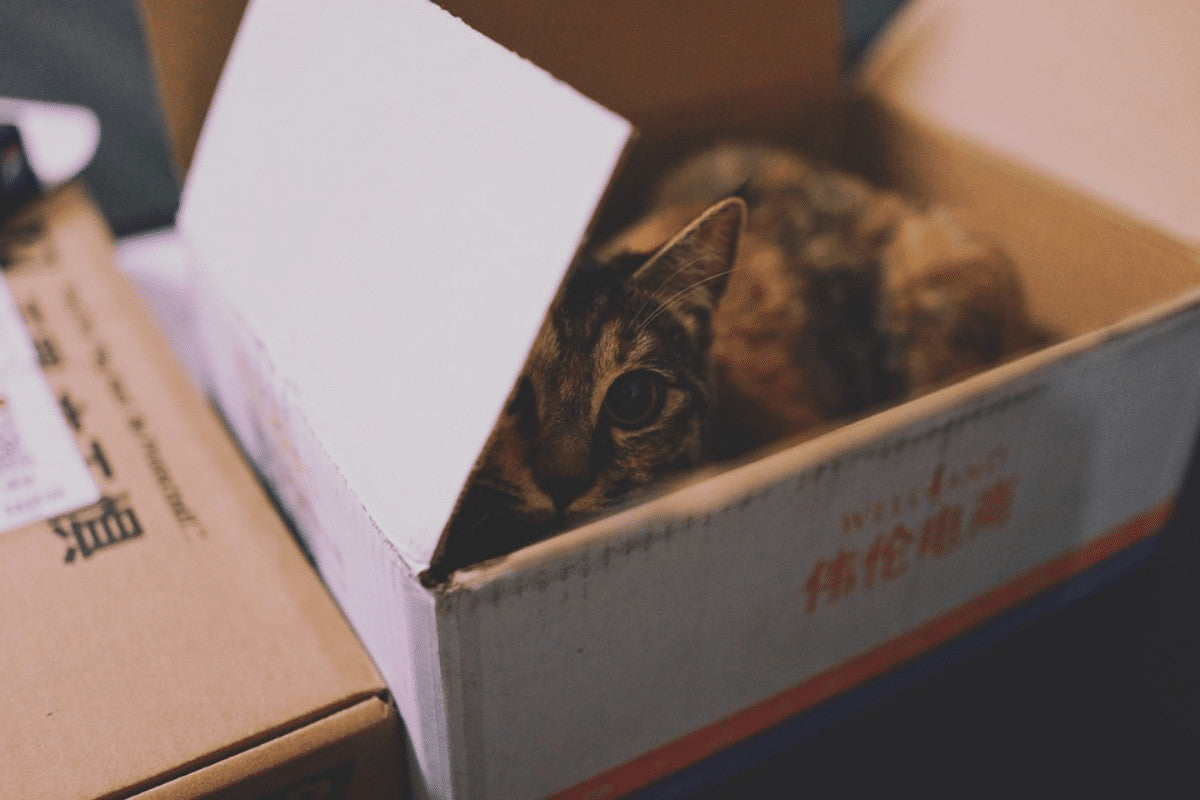Moving can be stressful enough, but throw a kitty or two into the equation, and it can be cat-astrophic! Cats are notorious for running away or trying to find their way back to their previous home, but there a few things you can do to help your pet adjust to its new environment relatively quickly and drama free.
In this article, we're sharing our top 11 tips for moving an outdoor cat to a new home. Although it will take some planning and patience on your part, it is doable. And in no time at all, your kitty will be settled and enjoying its new home.
11 Tips To Help Your Outdoor Cat Before, During and After Moving
From getting your cat microchipped and neutered to preparing a room in your new house, there a few things you can, and should do, to make sure the move is as stress-free as possible for you and your pets.
1. Microchip your cat
Outdoor cats have an excellent sense of direction, and can usually find their way home; however, a change of address can leave them feeling stressed out and disorientated. As a result, they could try and navigate their way back to their old stomping ground.
Before the big move, make sure your cat has been microchipped as well as neutered. Remember to also update your details on the company's database, as this is the only way for them to reunite you with your beloved pet in the event it goes missing.
2. Get your cat a collar

Although it seems a little old-fashioned in this technological age, you should also get a collar for your cat. Remember to include your contact number. It's also a good idea to leave your phone number with the people moving into your old house just in case your cat makes it way back there.
3. Let your cat get used to a carrier
One of the safest ways to transport your cat is in a carrier. Cats like tight spaces, and a cat carrier will make moving a lot easier for both of you. If your kitty is already used to one, that's a bonus. If not, don't worry.
Placing your cat's favourite toy, blanky, or edible treat inside the carrier will encourage it to climb in and recognise it as a safe space. Whatever you do, don't force your cat in as this will only make the moving experience more traumatic.
4. Keep your cat calm

It is vital that your cat stays as calm as possible leading up to, and including moving day. If possible, keep your cat in one room, away from the general chaos.
Make sure there is fresh drinking water, a litter box as well as toys, a hammock and depending on the weather, a cooling mat or self-heating blanket. If your cat shows signs of stress, you could use a calming diffuser or spray to help ease moving-day blues.
5. Get a room ready in the new house
Plan ahead and get a room ready for your cat in the new home. This will help your pet settle in, feeling safe and secure. We suggest placing your cat's bed, litter box, food and water, along with toys and boredom busters. To make the transition even easier, it is a good idea to put something in the room that has your scent. This could be a piece of furniture or an item of clothing.
If you have movers in and out the new house, let them know not to open the door or go in your cat's room. A spooked cat will run!
6. Give your cat time to adjust

An indoor cat may find it easier to adapt to a new house than one that spends all its time outside. But for your peace of mind, and your cat's safety, it is best to introduce it to a new environment slowly. We recommend keeping your pet in the same room for a few days. Leave the carrier door open so your cat can climb in should it feel threatened or overwhelmed.
Patience is critical during this process. Allow your cat to leave the carrier only when it's ready. Spend time with your cat in the room, and once all the mayhem of moving has died down, use treats to encourage exploration. Don't stress if your cat hides away. This is simply its way of acclimatising.
7. Keep your cat indoors
Experts recommend keeping outdoor cats inside for at least two weeks to get them used to their new surroundings. While this might prove difficult, especially if your moggy likes its independence, it will save you a lot of stress in the long run.
During this time, let your cat explore the rest of the house at its own pace. Make sure all windows and doors are shut, and all potential escape routes are blocked. Stay close to your kitty while it looks around, and offer words of encouragement, or tasty treats.
8. Make sure your cat is safe outside

Before you let your cat outside, you must make sure the immediate environment and new surroundings are safe. This means checking how busy the roads are and whether there are any potential predators, including strays or dominant neighbourhood cats around. You should also check your garden for any poisonous plants that could pose a threat to your cat.
Depending on the space you have available, you should set up an outdoor cat house or catio (cat patio). A shelter will protect it from the weather, while also giving it a place to hide when it feels threatened or scared. On the other hand, a catio is an excellent option to keep your cat safe in a contained area outdoors when there are too many potential risks.
9. Expect the unexpected
An outdoor cat will find the move stressful, so it's best to expect the unexpected. For example, if it's not trained to use a litter box, there is a good chance it will have an accident or two during its two-week lockdown period. Be patient, remain calm and remember your cat is adjusting to its new space.
Gently encourage your cat to use a litter tray by placing it in an accessible spot, preferably where your kitty feels comfortable. And don't leave clothes, blankets or towels on the floor as there's a good chance your cat will use these items as its portable potty. If you notice a puddle or a poo, clean it up quickly and place it in the litter box. The scent will lure your cat to the box next time it needs to go.
10. Use a leash

After the initial two weeks inside, your cat might be itching to get outdoors. We suggest using a leash the first few times so that your moggy doesn't make a run for it, or get lost. However, only do this if your cat is already familiar with a leash; otherwise, you will only stress it out more.
Don't leave your kitty unsupervised the first few times it goes outside. Stay close by and use treats and toys to keep it calm. Another good idea is to leave the front or back door open while you are outside with your cat. This will allow it easy access to your house in case it gets spooked.
11. Don't rush the process
All cats are different, and while one may adjust reasonably quickly to a new home, another will need more time. Don't rush the process. Even if two weeks have passed and your kitty isn't venturing outside, you shouldn't force it to do anything it's not ready for. Spend quality time with your cat, and offer lots of praise and treats.
Frequently Asked Questions About Moving Outdoor Cats
Moving is stressful enough at the best of times, but throw in a skitty kitty or a stray that's decided you are its family, can make the process even more difficult. In this section, we're looking at the most frequently asked questions about moving with outdoor cats.
If I put my butter on my cat's paws, will it still run away?
There is an old wive's tale that if your rub butter on your cat's paws when you move, it won't run away. The reasons for this are:
- While licking the butter off their paws, cats can check out their new environment, and as a result, become more familiar with their surroundings.
- Licking the butter takes a cat's mind off the fact that it is a new house, which reduces the stress.
- Buttering a cat's paws removes the smell of its old home, and gives them a chance to get used to the sights, sounds and odours of the new house.
While some people swear by this, we wouldn't recommend it. Not only will your cat feel more stressed out with butter on its feet, but it will also make one heck of a mess in your brand new home. As already mentioned, cats thrive on routine and like their own space. Preparation before, during and after the move will help ease your cat's stress and help it adjust it to its new home.
Should I take the stray cat when I move?
This isn't as straightforward as you think, which could make this situation somewhat tricky. Of course, if you have done everything possible to locate the owner and the cat has been living with you for a long time, then yes, you should absolutely take the stray cat with you when you move. We suggest you make sure you know about legal ownership of stray cats in the UK before the big move.
How long should I wait to let my cat outside after moving?
Experts recommend keeping your cat indoors for at least two weeks after a move. Keep in mind, this will vary depending on your cat's personality, and in some instances, it might take longer before your pet feels safe enough to go outside. This article will definitely help you if you are letting your kitty out for the first time.
Did you find this article helpful? Feel free to share it with a fellow feline lover and don't forget to sign up for weekly content, as well as special offers and discounts.









8 comments
“Excellent post
thanks for sharing.”
If you want to save huge? ? Then this is the best place for you where you can enjoy the best deals and coupons Watch now
“Taxi tải Thành Hưng hân hạnh cung cấp tới quý khách dịch vụ taxi chuyển nhà, taxi tải chuyển văn phòng, dịch vụ cho thuê xe tải, dịch vụ chuyển nhà trọn gói Hà Nội và TPHCM.
CÔNG TY CỔ PHẦN TẬP ĐOÀN THÀNH HƯNG
Tổng đài miễn cước toàn quốc: 1800.00.33
Website chính thức: https://taxitaithanhhung.com/
Chuyển nhà trọn gói -> https://taxitaithanhhung.com/dich-vu-chuyen-nha-tron-goi-thanh-hung/
Chuyển văn phòng trọn gói -> https://taxitaithanhhung.com/chuyen-van-phong-tron-goi-thanh-hung-gia-re/
Trụ sở chính: 129 Hồng Tiến, Bồ Đề, Long Biên, Hà Nội (địa chỉ cũ: 104 Nguyễn Văn Cừ, Long Biên, HN)
SĐT: 024.38.733 – 38.73.13.13 – 38.725.725.
Chi nhánh tại TP.HCM: 1942/1C Vườn Lài nối dài, P.An Phú Đông, Quận 12
SĐT: 028.54.360.360 – 39.876.876 – 62.90.90.90”
Grab tremendous deals ? through devilsfilm coupon code
Grab tremendous deals through ? through devilsfilm coupon code
Very Informative Blog. Your Pro Tips really helps in Per Industry.
Thanks for sharing
keep it up.
www.koliey.com
We are thinking of getting a kitten ?⬛
It’s been a very long time
We have 2 dogs now
We will be moving to new location in about 4 months – Should we wait and let him- her outside once we are in the new location for about 2-3 weeks ?
It’s wonderful to know your article! It gon’ be useful for my little cat. Thank u so much